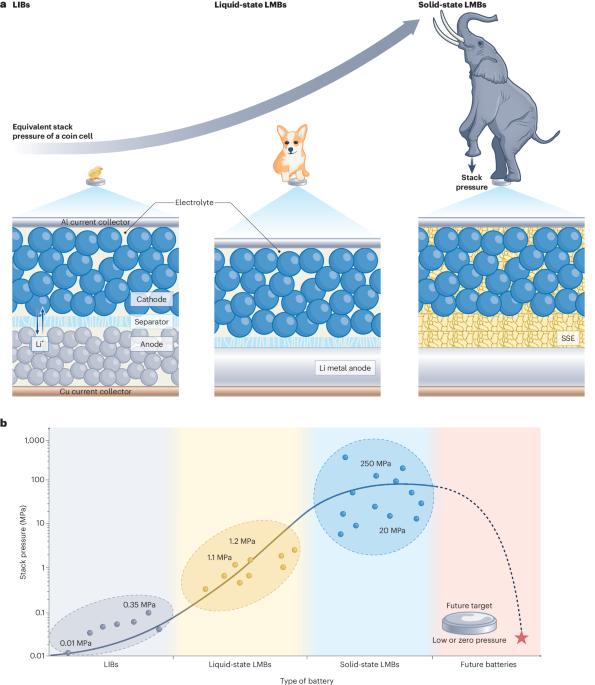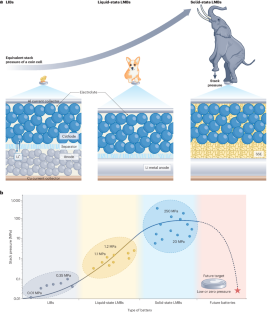电池的堆压至关重要
IF 60.1
1区 材料科学
Q1 ENERGY & FUELS
引用次数: 0
摘要
叠层压力对于确保电池中固体-固体界面接触至关重要,它在其中起着特别关键的作用。电池堆压水平的巨大变化困扰着寻求确定最佳值的研究人员,并导致我们对堆压如何与电池化学相互作用的理解存在实质性差距。在这里,我们强调了电池堆压的重要性,并主张考虑临界堆压经验模型作为确定最佳堆压的手段。我们首先分析广泛的堆压范围,它跨越多个数量级。然后,我们将它们的影响分为四个不同的阶段,并解释了它们的作用。此外,我们还研究了堆压的电化学-力学关系,以揭示耦合效应。今后对堆压的研究应集中在对标、诊断、空间分布和最小化等方面。对电池堆压力的深入了解将有助于开发更可靠、更实用的电池设计。本文章由计算机程序翻译,如有差异,请以英文原文为准。


The critical importance of stack pressure in batteries
Stack pressure is essential for ensuring solid–solid interfacial contact in batteries, where it plays a particularly crucial role. The wide variation in stack pressure levels in batteries has perplexed researchers seeking to determine an optimal value and has led to substantial gaps in our understanding of how stack pressure interacts with battery chemistry. Here we highlight the critical importance of stack pressure in batteries and advocate for considering a critical stack pressure empirical model as a means to determine the optimal stack pressure. We begin by analysing the broad range of stack pressures, which span multiple orders of magnitude. We then categorize their effects into four distinct stages and explain their roles. Additionally, we examine the electrochemomechanical relationship of stack pressure to reveal a coupled effect. Future research on stack pressure should focus on areas such as benchmarking, diagnosis, spatial distribution and minimization. A deeper understanding of stack pressure will facilitate the development of more reliable and practical battery designs across various chemistries. Stack pressure plays a critical role in battery performance, influencing electrochemical behaviour, material integrity and system efficiency. The authors analyse existing stack pressure data and establish relationships between stack pressure and battery performance to provide insights for improving battery design and efficiency.
求助全文
通过发布文献求助,成功后即可免费获取论文全文。
去求助
来源期刊

Nature Energy
Energy-Energy Engineering and Power Technology
CiteScore
75.10
自引率
1.10%
发文量
193
期刊介绍:
Nature Energy is a monthly, online-only journal committed to showcasing the most impactful research on energy, covering everything from its generation and distribution to the societal implications of energy technologies and policies.
With a focus on exploring all facets of the ongoing energy discourse, Nature Energy delves into topics such as energy generation, storage, distribution, management, and the societal impacts of energy technologies and policies. Emphasizing studies that push the boundaries of knowledge and contribute to the development of next-generation solutions, the journal serves as a platform for the exchange of ideas among stakeholders at the forefront of the energy sector.
Maintaining the hallmark standards of the Nature brand, Nature Energy boasts a dedicated team of professional editors, a rigorous peer-review process, meticulous copy-editing and production, rapid publication times, and editorial independence.
In addition to original research articles, Nature Energy also publishes a range of content types, including Comments, Perspectives, Reviews, News & Views, Features, and Correspondence, covering a diverse array of disciplines relevant to the field of energy.
 求助内容:
求助内容: 应助结果提醒方式:
应助结果提醒方式:


